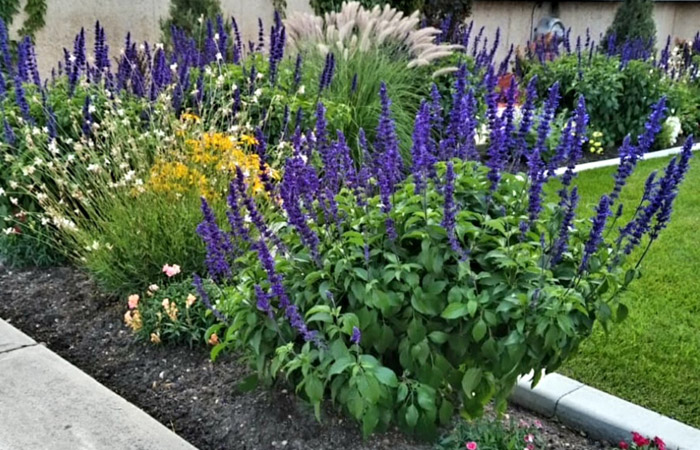Deeply Rooted
Perennial Annuals or Annual Perennials?

Not many people know this but amongst our annuals and perennials there are some that come in both annual and perennial. I’m not talking about hardy annuals that can winter over, like Creeping Jenny and Charlie. I’m talking about plants that have a perennial variant and annual variant. I want touch on a couple varieties so that you can make educated decisions for what would be the best fit for you when it comes to these certain plants. The varieties we will be touching on are Salvia, Rudbeckia, and Geraniums. There are many more still that I will list at the end in the honourable mentions, but I only have time for three varieties today. So, lets get into it!
I want to start with the Geraniums because I don’t want to get your hopes up for perennial Geraniums that look like our annual Geraniums. Perennial Geraniums, also known as Sticky Geraniums or Cranesbill, look very different from the annual Geraniums despite their family relations. Perennial Geranium can range from a low growing plant to a mounding plant with individual flowers rather then the balls of flowers that the annual Geraniums produce. Now don’t get me wrong, even though the perennial version is different from the annual, the perennial version is still beautiful! Their blooms can come in all different shades of pinks, blues, purples, and sometimes soft whites. Perennial Geraniums are actually native to our Manitoba woods. So not only are they beautiful, but they are hardy, non-invasive and, as far as I can tell by my research, not damaging to our eco system. Now that being said there is a variety of Geranium called Shiny Geranium or Shining Cranesbill and this species is invasive and is a dangerous species. It is aggressive and can choke out the native undergrowth. Though this is more commonly an issue in B.C. if you see these flowers, please do not buy them! There are also many helpful research pages on the internet that tell you how to identify these invasive plants and what to do with them should you find them.
Another variety of plant that comes in both annual and perennial options are Rudbeckia, specifically black eyes Susan’s. Also known as Cone flowers, Rudbeckia is a very popular plant due to its incredible growth structure and brilliant golden colour. I have heard both sides of the argument with this one, “I wish it only lasted the season so I can just rip it out at the end of the season and not think about it.” Or “I wish this plant was perennial, I want these blooms to come back every year without having to buy and plant every spring.” Well, your covered on both fronts! Rudbeckia Goldstrum and Rudbeckia Prairie Sun are the two varieties I want to touch on today. Let’s start with the perennial variety, Rudbeckia Goldstrum. Perennial Rudbeckia get fairly large, reaching 2 – 3 feet in height and about 1 – 2 feet in width. Though Perennial Rudbeckia have a clumping upright structure, when in a “colony” Rudbeckia have a tendency to get large and in charge, which depending on the garden may be exactly what you want. Annual Rudbeckia, Rudbeckia Prairie Sun, has a slightly different growth structure. Annual Rudbeckia gets 2 – 3 feet tall and 1 1/2 – 2 feet wide, with an upright spreading structure. Annual Rudbeckia will obviously not be as aggressive so if you plant them in a “colony” they will bush out nicely but are limited by time and weather, keeping them from taking over your garden as time goes on. Prairie Sun Rudbeckia are known as a short-lived perennial in some areas that are a little warmer than us, but here in Manitoba it is recommended to treat them as annuals as they will not come back after the winter. Rudbeckia are long lasting bloomers that put on a magnificent show, their large golden blooms put on display for most of the summer and fall.
The last plant I want to touch on is Salvia. Perennial Salvia and annual Salvia are incredibly similar with a few differences, the main being that one is perennial, and one is annual. Depending on which varieties you get there may be larger difference such as colour, leaf structure, and height. The three varieties I want to touch on are the Big Blue annual Salvia, Nemorosa Caradonna Perennial Salvia, and common herbal Sage which is annual. Now off the bat, these three definitely have some differences again the biggest one being the leaves. The perennial Salvia, Caradonna, has a lighter green, narrow, long leaf similar to herbal sage. The annual Salvia, Big Blue, has large heart shaped leaves with a darker green colour. And the common herbal Sage has a long and narrow silvery green leaf that has a fuzzy texture. And of course, the only edible version of these Salvias is the common herbal Sage. The Caradonna Salvia grows to be 1 1/2 – 2 feet tall and just about as wide with a very upright and rigid structure. The flower stocks are a rich purple to violet blue, and they bloom from spring till mid summer. The Big Blue salvia grows to be about 2 – 3 feet tall and just as wide with a gorgeous upright rounded structure. Their flower stocks are a rich blue-purple and tend to be thicker than the perennial blooms. Big Blue Salvia blooms from summer straight until fall making this a great feature plant for your flowerbeds! Common herbal sage tends to get 1 – 2 feet tall and wide and isn’t particularly known for its blooms. Though they do get dainty pink to purple flower stocks if they are allowed to grow tall enough, often heavy harvesting of the herb will prevent them from flowering and seeding.
And last but not least, the honourable mentions of plants I didn’t have enough space to write about. Gaillardia, Lavender, Dianthus, and Dahlias are all plants that come in both a perennial and an annual variant. Maybe I will touch on those in the future.




